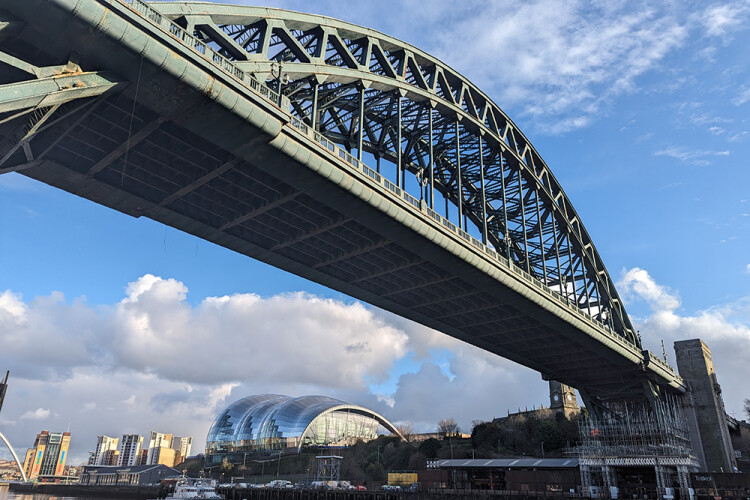It used to be said that any job destined never to be completed was “like painting the Forth Bridge” – a phrase now redundant as that task was finally accomplished in 2011 after almost 140 years.
Despite that achievement, there’s no denying that refurbishing a major road or rail bridge is a significant undertaking and one that is seldom tackled all at once.
The Tyne Bridge, linking Gateshead on the south bank with Newcastle to the north, is a similarly famous landmark, albeit a more recent structure than the Forth Bridge, having been completed 38 years later in 1928.
But in the almost 100 years since its completion, the Tyne Bridge has never been fully refurbished. Maintenance so far has comprised routine inspections and the occasional facelift – in most cases comprising no more than a lick of paint.
Now, however, the Tyne Bridge is getting the full treatment for the first time. Newcastle City Council and Gateshead Council, which jointly own the structure, have engaged local contractor Esh Construction to carry out a programme of work that includes steelwork repairs, grit blasting and re-painting, concrete and masonry repairs, drainage improvements, bridge deck waterproofing and resurfacing and bridge joint replacement.
The aim is to get the bridge returned to its former glory in time for its 100th anniversary in October 2028.
Work on the project began almost two years ago with an exhaustive programme of on-site inspections that have continued for the past 20 months. Using a battery of access methods – including hydraulic platforms, drones and rope access – engineers have crawled and climbed over the whole structure to ascertain the extent of the bridge’s deterioration and the scope of the work required.
“This is a very technical project,” says Esh special projects construction manager Stephen McClean. “It’s non-standard, not off-the-shelf. In 2000 the road deck was resurfaced but until now it’s been a case of maintenance work every 20 years or so, mostly consisting of over-painting.
“In 2000 the whole bridge was scaffolded so it could be repainted but this time we’re taking it back to bare metal,” he adds.
Blasting away years of accumulated paint – some of it lead-based – is a potentially hazardous operation, both for those working on or near the bridge and for the environment. So the scaffolding will be fully encapsulated in shrink-wrap sheeting to contain the debris.
In September last year scaffolding specialist Infrastructure Site Services (ISS), headquartered in nearby Blyth, started erecting the first of what will be a series of scaffold structures ready for Esh to start on the repair work.
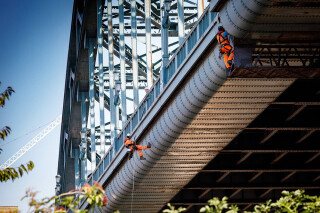
Esh was appointed in June 2022 but it was only last month – after a series of nail-biting delays – that the £35.2m of funding promised by the Department of Transport was finally signed off. Although the two local authorities stumped up the cash for the inspections and enabling works, the project could not go ahead without the government’s contribution.
Any delay to the project risks missing the deadline of the bridge’s centenary celebrations. But at this stage it also interferes with the carefully-planned series of operations designed to work around the colony of kittiwakes that nest on the bridge.
The Tyne Bridge, and the nearby Baltic Centre for Contemporary Art, are unique in being home to the world’s furthest-inland colony of kittiwakes. These graceful seabirds, related to the gulls, normally nest on remote cliffs and rock ledges and spend most of their lives out at sea. Their presence in the centre of this English metropolis makes them truly special.
Scheduling of the scaffold erection has been critical to the wellbeing of these protected birds. Their breeding season runs from late February through to August and they are now returning from the open ocean to start building their nests. It is essential that the work on the bridge is arranged so as not to interfere with the birds at this time.
With guidance from ecologists and the Tyne Kittiwake Partnership, Esh is currently installing specially-designed nesting locations on the bridge towers. “They’re designed to replicate the usual nest ledges. It’s a tried-and-tested method that is commonly used in Norway,” explains McClean.
Nor are the kittiwakes the only wildlife that needs special protection. Last year, having waited until the end of the kittiwake nesting season, ISS started erecting the scaffold just as the salmon spawning season, which runs from September to March, was getting under way.
The Marine Management Organisation, which issued the marine licence for the project, imposed strict conditions forbidding the shining of any lights directly into the water for fear that this could spook the migratory salmon and sea trout during their nocturnal journey to their upstream spawning grounds.
The scaffolding operation is being carried out in phases, with the first structure erected under the lower-arch section of the bridge at the Gateshead end.
“The bridge essentially comprises a huge steel arch with the road deck running through it. We’ve erected a huge birdcage scaffold around the lower Gateshead arch section where the road deck intersects the arch,” says ISS operations director Christian Farquhar. “There are cafes, bars and shops under the arch and our birdcage straddles all of these.”
To protect the people and premises working below the scaffold, ISS has erected a 22m X 22m crash deck over the birdcage scaffold. As well as providing protection below, the crash deck also carries the weight of the scaffolding above.

To support this loading, the crash deck sits on 16 towers, each comprising a cluster of up to 14 legs and each transferring a load of 120kN into the ground.
The scaffold then rises from the crash deck to the underside of the road deck at which point beams are cantilevered out beyond the width of the bridge parapet. ISS then builds more scaffolding up from these cantilevered beams to two metres above the footpath that runs along the edge of the road deck on the outside of the main steel arch.
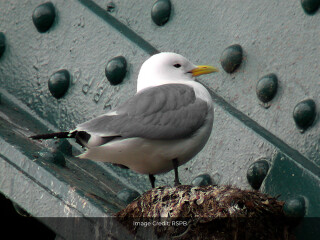
“We call this the ‘up-and-over’ and when we’ve completed it the whole scaffold structure will be completely contained within the sheeting,” says Farquhar.
After Esh has completed its work within this scaffold, ISS will erect an almost identical scaffold around the lower arch section at the opposite (Newcastle) end of the bridge on the northern bank. This will be a virtual mirror image of the Gateshead structure, except that there are no shops or bars here and the birdcage scaffold and crash deck will be erected over the road and footpaths.

The two stone towers that support the bridge at either end are thought to be in good condition although inspections are continuing and the full scope of the work has yet to be confirmed. However, if repairs are required to the towers’ internal steelwork, ISS will erect scaffolding inside the towers to facilitate this.
When work is completed on the two lower-arch sections of the bridge, attention will shift to the arch and road deck of the main span.
The first operation will be to erect a temporary scaffold suspended from the bridge; a gantry system on aluminium running beams underneath the road deck. This lightweight scaffold is designed simply to provide access from which ISS can then assemble the main bridge scaffold.
This phase will see the road deck scaffolded and sheeted from the northern (Newcastle) bank to the mid-point of the span; the following phase will see the other half of the span scaffolded in the same way from the Gateshead end. This phase will enable Esh to carry out crucial repairs to the main hangers where they pass through the footpath along the road deck.
“The requirement to do everything in sections came from Esh,” says Farquhar. ”Following their inspections, they gave the brief to [scaffold designer] 48.3, who produced the design and calculations in phases. Then we developed the methodology.”
The scaffolding design and erection regime has evolved through this iterative process and remains fluid – inspections are still being carried out. “We have to keep in mind how the scaffold will be used – who is it for? What are their requirements?” – different trades have different needs, he says.
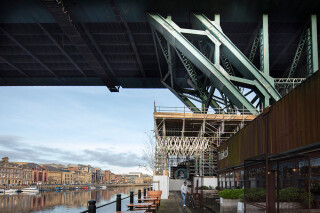
The design is also influenced by the equipment available, says Steve Benton, principal engineer with scaffold design specialist 48.3. “Our design has to take account of what ISS can deliver in terms of inventory and equipment. The majority of it, though, is standard tube-and-fittings”.
Nevertheless ISS has invested in some specialised equipment to meet the design requirement. “We’ve had a large number of 1.3m-deep Apollo Double-X aluminium beams made specially for this job,” says Farquhar. “But these are not job-costed – it’s a long term investment to increase our capabilities.”
While the majority of simple scaffolds are erected to standard designs by independent scaffolding contractors, a project of this complexity demands specialist design expertise. “We’ve worked with 48.3 many times – there’s a couple of designers that we always partner up with, and they are one,” he adds.
“Only a few of the biggest scaffolding firms have their own in-house design department. We’ve considered it but most of the time it’s just not worth it. You have to have Cat2/3 checks done by an independent third-party anyway, so it makes more sense to use a third-party designer in the first place,” explains Farquhar.
On this project, Esh brought in 48.3 even before the scaffolding contract was put out to tender. “Esh needed to get 48.3 on board as early as possible because they needed to give the client an indication of the scope of the works. However, we did provide pre-contract design input free of charge at this stage,” he says.
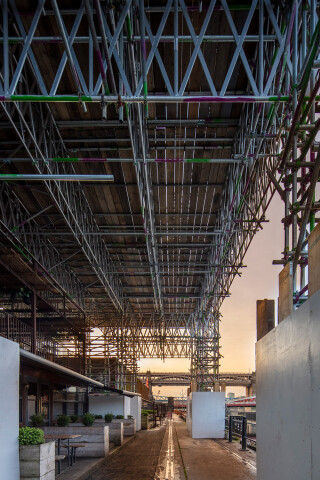
In terms of quantities, Farquhar estimates that around 200 tonnes of scaffolding will be erected around each of the lower arches and between 400 and 500 tonnes in total used to scaffold the road deck.
“We’re sheeting Gateshead right now and we’ll be starting to erect the scaffold round the Newcastle lower arch in September. The temporary scaffold under the road deck will start in summer 2025,” he says.
Where the arch rises past the road deck, ISS will then build a crash deck over the carriageway to protect live traffic (one lane of traffic must be maintained in each direction throughout the project).
Once the road deck scaffolding is dismantled ISS will then scaffold the arch. Work on this element and the hangers will start in 2026/7.
“Because of the way this project is phased, we will be on site throughout the whole project,” says Farquhar. “We were the first on-site – and we’ll probably be the last to leave”.
WHO IS ISS?
Infrastructure Site Services (ISS) is a young company, established in 2016. But its management team can boast a wealth of experience in large-scale industrial projects throughout the northeast.
The business was set up by Mark Buglass, previously area manager for Pyeroy, a specialist in coatings, access and structural maintenance for the offshore industry.
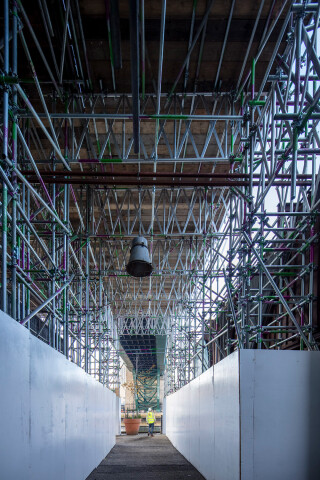
“Everybody here started out at Pyeroy,” says ISS director Christian Farquhar. Pyeroy was sold to the Wood Group, a huge international industrial services corporation, in 2013 and and the focus of the business started to change. “So we all went off and did our own thing for three or four years,” he explains.
Buglass worked for other scaffolding contractors for a couple of years before setting up ISS. Then he started recruiting his old colleagues. Today the company employs about eight office staff plus between 30 and 40 site operatives.
With their combined pedigree in offshore and industrial scaffolding, the ISS team started to build a reputation for complex civils projects. “Our work is mainly repeat business,” says Farquhar.
Bridges are now a speciality: the company is currently working not only on the Tyne Bridge but also its upstream neighbour, the Grade I-listed High Level bridge, which is undergoing a £4m revamp; and in 2022 ISS won the NASC small project of the year award with its work on the Swaith Viaduct refurbishment in Barnsley.
“We’re also working on a steel bridge in London and a train depot in Manchester,” says Farquhar.
The business which had revenues of about £6.5m last year, is in good financial shape, says Farquhar, though he says the past couple of years have been tough for the scaffolding sector – “especially if you’re in house-building, which thankfully we’re not,” he adds.
Got a story? Email news@theconstructionindex.co.uk

